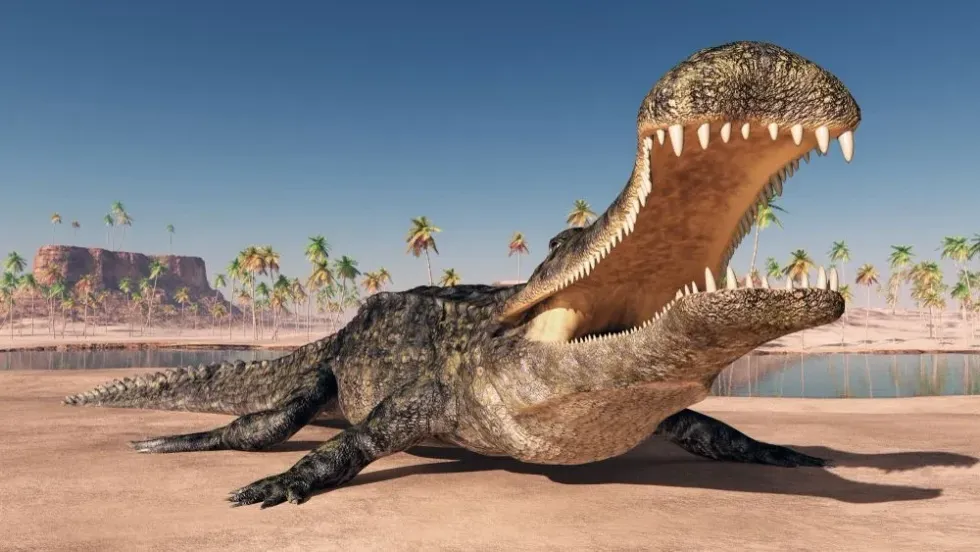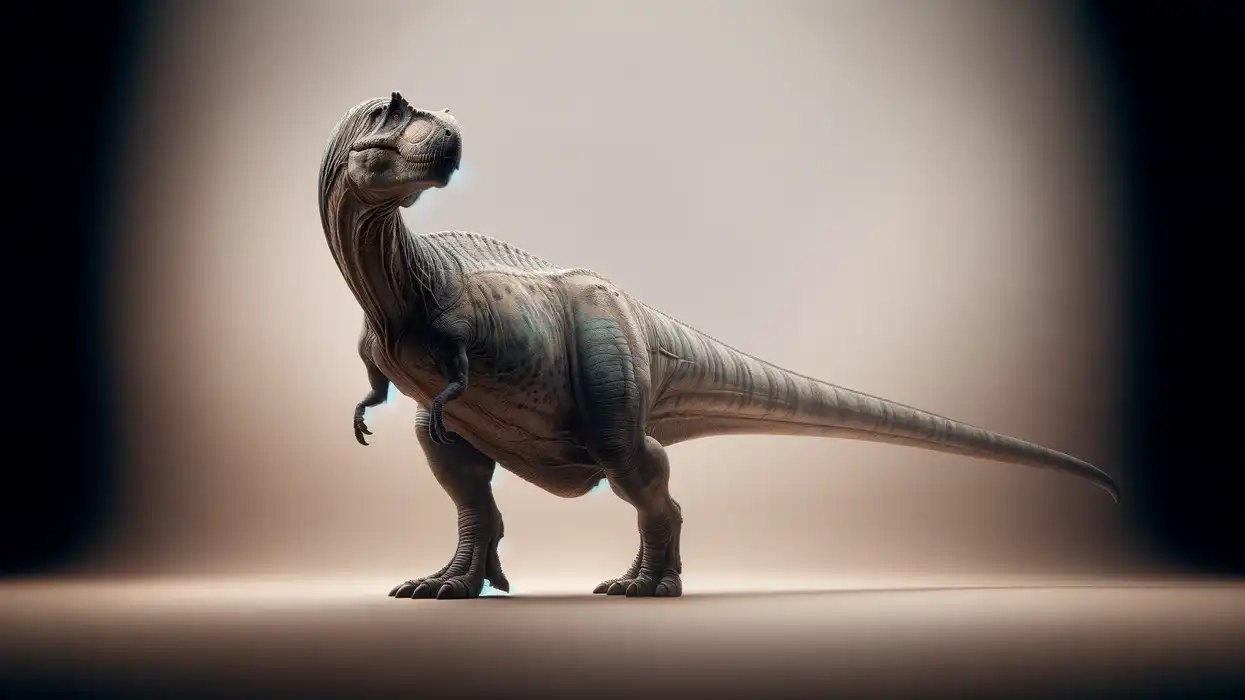Will you believe it if we say that there was a reptile that was twice the size of modern crocodilians? Most probably, the answer would be a big no.
However, we have tons of facts to make you believe, come on, let us find out. Famously known as 'super-crocs', Sarcosuchus is an Extinct genus of crocodilians that belonged to the Early Cretaceous period that spanned from 145-100.5 million years ago.
These reptiles are believed to be distant relatives of modern crocodiles. While talking about the body size, the average weight and length of fully grown reptiles are said to be around 3.9-4.9 tons (3500-4500 kg) and 30-31 ft (9-9.5 m), respectively.
Albert-Felix de Lapparent, a French Paleontologist discovered several fossils of a large crocodyliform from the Continental Intercalaire Formation in Morocco. Remains were also discovered in Mali, Algeria, Ain el Guettar Formation, Tunisia.
In 1957, skeleton remains were found Elrhaz Formation, Niger. A new species of the genus was discovered somewhere around northeastern Brazil in 1977.
Thus it can be said that these giant crocodiles must have lived in several parts of South America, and Africa including the Sahara Desert. An American paleontologist, Paul Sereno discovered around six specimens, including a partial skeleton with several parts of the spine.
The narrow-snouted crocodile had telescoped eyes, while the snout comprised around 75% of the length of the skull. The upper jaw had 35 teeth on each side, while the lower jaw had 31 teeth on each side. The lower jaw was quite shorter than the upper jaw and a gap was visible when the jaws were closed.
Let's read more fun facts about the Sarcosuchus, and if you find this article interesting, don't forget to check out exciting facts about different animals Protosuchus and Longisquama.
Sarcosuchus Interesting Facts
Was the Sarcosuchus a dinosaur?
No, the Sarcosuchus is not a dinosaur, the reptile was one of the largest crocodiles found in the Early Cretaceous period. These crocodiles were extreme predators and used to hunt huge mammals quite easily.
When it comes to the adult's size, the average body weight and length of these fully grown reptiles is said to be around 3.9-4.9 tons (3500-4500 kg) and 30-31 ft (9-9.5 m), respectively.
How do you pronounce 'Sarcosuchus'?
You just have to break the whole term into several syllables, so Sarchosuchus is pronounced 'sar-ko-sue-kus'. The genus name, Sarcosuchus, is a combination of two Greek words, 'sarco' and 'suchus' and the meaning of the term is 'flesh crocodile'.
What type of prehistoric reptile was a Sarcosuchus?
The giant crocodile of the Early Cretaceous period belonged to the Tethysuchoidea and the Sarcosuchus genus. The genus consists of two species, Sarcosuchus imperator and Sarcosuchus hartti. It is also said that these crocodiles are a part of Pholidosauridae, a group of crocodile-like reptiles. Since it was not a saltwater crocodile, the reptile was associated with Tethysuchia.
In which geological period did the Sarcosuchus live?
The crocodile belonged to the Early Cretaceous period that spanned from 145-100.5 million years ago. During this period, the reptile must have lived in several countries of South America and Africa, including the Sahara Desert.
When did the Sarcosuchus become Extinct?
The crocodile must have become Extinct somewhere between 133-112 million years ago (from the Late Hauterivian to the Early Albian stage). The reason for extinction is not clear as of now, but reptiles became Extinct due to several reasons such as climate change, volcanic eruptions, asteroid impacts, drought, and many more reasons.
Where did the Sarcosuchus live?
The remains of this crocodile were found in several regions of the South American and African continents. Albert-Felix de Lapparent discovered the initial fossils from the Continental Intercalaire Formation, Morocco, remains were also discovered from Mali, Algeria, fossils were also found from the Ain el Guettar Formation, Tunisia, and Elrhaz Formation, Niger.
A new species of the genus was discovered somewhere around northeastern Brazil in 1977.
What was a Sarcosuchus' habitat?
Like modern-day crocodiles, these giant reptiles, belonging to a group of crocodile-like reptiles, used to inhabit lakes, rivers, and wetlands. Their habitat must have provided a suitable place for hunting prey like fish, and mammals.
Who did the Sarcosuchus live with?
Very little information regarding their social behavior is available as of now, but like modern crocodiles, these reptiles might have been solitary. Although, sometimes they would have worked together while hunting. These primitive reptiles must have formed large congregations in areas with an abundance of prey. Also, they used to appear in pairs during the breeding season.
How long did a Sarcosuchus live?
The exact life span of the crocodile is not known as of now. These reptiles and other members of the Tethysuchoidea clade must have lived quite long. Also, the average life span of modern crocodiles is around 50-80 years.
How did they reproduce?
These reptiles must have reproduced like other species of the Tethysuchoidea clade. Like modern-day reptiles and birds, these reptiles used to reproduce by laying eggs. They also performed several courtship displays to attract potential partners and males must have fought over females.
Their clutch size is not known as of now, but the fossil suggests that the nesting site was in the vicinity of a lake. Also, adult reptiles must have taken care of the young ones.
Studies revealed that young reptiles were dependent on adults for a shorter period of time, while female reptiles must have provided food for a few days of life.
Modern crocodiles follow the polygyny mode of reproduction in which males mate with multiple females. It is not known whether such a mode was used by these primitive reptiles or not.
Sarcosuchus Fun Facts
What did a Sarcosuchus look like?

Not the biggest crocodile, but one of the largest and strongest reptiles of the Cretaceous period, this super-croc was known for growing at a steady speed throughout its lifetime. The snout comprised around 75% of the length of their skull. The huge body and sharp teeth must have helped in hunting big fish and mammals.
How many bones did a Sarcosuchus have?
The exact number of bones they had is not known as of now, but several parts of the Sarcosuchus skeleton were discovered during the course of several expeditions. Fragments of the skull, vertebrae, teeth, and scutum were found from the Ain el Guettar Formation, Tunisia.
In Elrhaz Formation, Niger, several isolated teeth of huge size were found and this also suggested that the reptile had a huge snout.
From the region of Gadoufaoua, Niger, a complete skull was discovered by the team of Frech CEA. In Brazil, two isolated teeth were found.
How did they communicate?
Like modern-day crocodiles, both the species of the Sarcosuchus group must have used similar methods to communicate with each other. Crocodiles are known for having sophisticated communication abilities, they possessed threat calls, booming sounds.
They have exceptional vision, highly developed smell, and can easily sense the movement in the water. When you combine these features with their powerful teeth and jaws, they become one of the intimidating predators.
How big was the Sarcosuchus?
While talking about the Sarcosuchus size, the average weight and body length are estimated to be around 3.9-4.9 tons (3500-4500 kg) and 30-31 ft (9-9.5 m), respectively. They were bigger than other crocodile-like reptiles such as Ornithosuchus saltwater crocodiles.
How fast could a Sarcosuchus move?
The speed of this reptile is unknown. However, large crocodiles have a swimming speed of around 15-22 mph (24-35 kph), while a few species such as the Nile crocodile have an average speed of 22 mph (35 kph).
How much did Sarcosuchus weigh?
The average weight of the reptile was 3.9-4.9 tons (3500-4500 kg).
What were the male and female names of the species?
There are no sex-specific names used to refer to the male or female Sarcosuchus.
What would you call a baby Sarcosuchus?
The babies of Sarcosuchus are known as hatchlings.
What did they eat?
As they were carnivores, studies reveal that these dinosaurs might have fed on big dinosaurs, large mammals, fish, and turtles.
How aggressive were they?
They were solitary but may have attacked intruders while avoiding predation.
Did you know...
Deinosuchus, an extinct crocodile, was twice the size of Sarcosuchus.
Why is it called Sarcosuchus?
The genus name, Sarcosuchus is a combination of two Greek words, 'sarco' and 'suchus', the meaning of the term is 'flesh crocodile'. Due to its flesh-eating habits, it came to be known as Sarcosuchus. It was one of the most dangerous and predatory reptiles of the Cretaceous period.
Did Sarcosuchus live with Spinosaurus?
Studies reveal that both, Sarcosuchus and Spinosaurus lived together and shared the same region of present-day Morocco. Unlike Sarcosuchus crocodiles, the Spinosaurus dinosaurs were not found in Algeria, Mali, or Niger.
Also, both reptiles had long thin snouts and must have fought with each other for limited food resources. Fossils suggest that a fully-grown Sarcosuchus crocodile would have been capable of breaking the neck of the large fish-eating Theropoda, Spinosaurus. The former was the largest meat-eating reptile that ever lived.
Here at Kidadl, we have carefully created lots of interesting family-friendly prehistoric animal facts for everyone to discover! Learn more about some other creatures from our Nothosaurus interesting facts, or Azendohsaurus facts for kids.
You can even occupy yourself at home by coloring in one of our free printable Sarcosuchus coloring pages.










